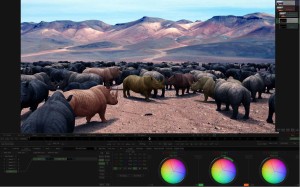![]()
 At NAB, SGO announced that it has added a new Spatial Isolation Toolset to its Mistika version 8.2.
At NAB, SGO announced that it has added a new Spatial Isolation Toolset to its Mistika version 8.2.
In both 2D and Stereo 3D finishing it is common for multiple objects to brought together from separate creative systems, using masks, object IDs, positional information, travelling mattes, and so forth, and in the case of live-action stereo 3D, associated z-depth maps. Unfortunately, it is standard practice for such information to be dropped before entering the online grading and finishing, especially when the number of objects being combined is large in number, resulting in a single-plane image with no ability to re-adjust objects independently within the grading and finishing stage of the project workflow.
SGO’s Spatial Isolation Toolset maintains all of the associated object data, enabling users to select any object or group of objects work interactivity with them later in the grading process.
A colorist can use any object selection options by single clicking any elements or part of an element, correcting only object surfaces pointing in certain directions, or separate objects by a z-depth range selection, all of which can be combined with traditional object isolation modes, such as windows and color or luminance range selection, but now with total object isolation.
What Spatial Isolation offers is not compositing – it is object separation inside the color grading workflow, using the information provided by the previous effects and compositing systems. This means it is no longer necessary to spend time attempting to fine-tune an object’s integration with its surroundings within effects systems, instead allowing Mistika to creatively light and grade 3D objects.
When working with stereo 3D footage the associated z-depth map can just as easily be used to perform object and image plane isolation, allowing the colorist to perform far greater creative manipulations, from grading and color correction, to defocus, and re-lighting, further enhancing the reality that stereo 3D can bring to the big screen.





